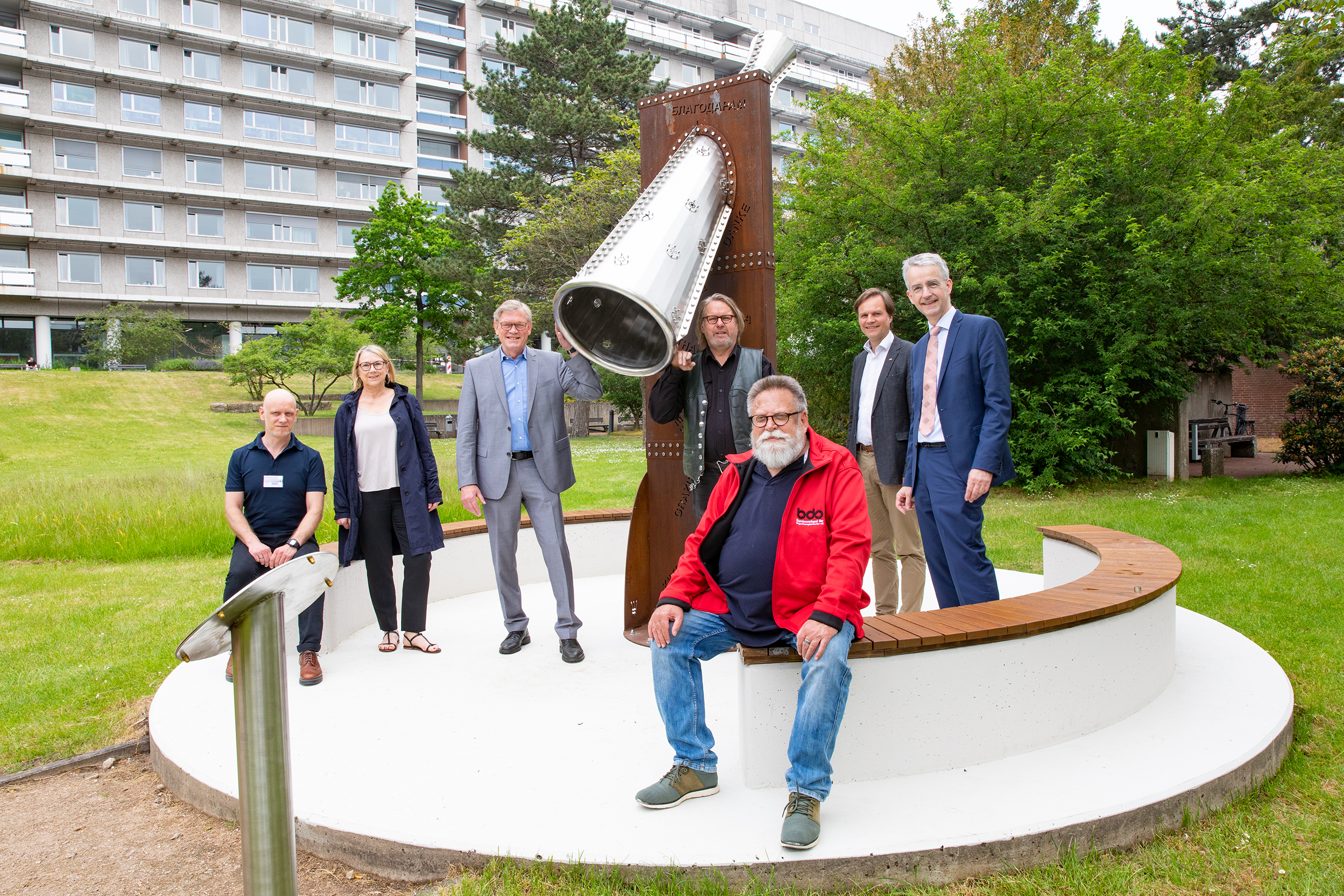Inaugurated on Organ Donation Day: New sculpture in the patient garden commemorates people who have donated an organ or tissue

Scenes during the inauguration in the MHH patient garden; Copyright: MHH / Karin Kaiser.
07.06.2021
Gifts are a beautiful thing. They can be loving, personal and valuable. Many gifts, however, are much more than that. They are priceless. And sometimes they can even save a life. Donations of organs, tissue or blood are such gifts. Without them, many hospitals would not be able to help their patients adequately, and those affected would not be able to live at all or only with great restrictions. Anyone who would like to say thank you for these mostly anonymous donations can now do so in the patient garden at Hannover Medical School (MHH). On the initiative of the Clinical Ethics Committee (KEK) of the MHH, the "DankeMal", an interactive sculpture by the artist Andreas Rimkus, has been created there. On Saturday, June 5, 2021, the Day of Organ Donation, the work of art, financed mainly by donations, was inaugurated.
Success story transplant medicine
At the inauguration, MHH Vice President Professor Dr. Frank Lammert, responsible for the Department of Health Care, emphasized: "Organ donation is important and life-saving. More than 1,000 people are currently waiting for a new organ at MHH alone." Since 1968, more than 15,000 organs have been transplanted in Hannover, and so far this year there have been more than 150. "Transplant medicine at the MHH is a success story" - but until now there had been no place where transplanted patients could say thank you. This has now been created.
Organ donation is a gift
"The 'DankeMal' is intended to be a place of silence and thanks," said Dr. Gerald Neitzke, KEK chairman. The visitors should come to rest there, organize their thoughts and feelings and, if they wish, express their thanks. This was also the wish of the person who came up with the idea, MHH professor Dr. Roswitha Müller. "It was important to Professor Müller to emphasize the very special character of these donations. After all, here a person gives away what is actually an unavailable part of his or her body out of human solidarity," explained Dr. Neitzke. Organ donation is a gift. Professor Mueller had committed herself to the project until her retirement.
Day of the organ transplantation is for persons concerned like a second birthday
Professor Dr. Axel Haverich, head of the MHH Transplant Center and director of the Clinic for Cardiac, Thoracic, Transplantation and Vascular Surgery, thanked the initiators and the artist, as did Professor Lammert. "Organ donation creates new life," he emphasized. "Many organ recipients celebrated the day of their transplant like a second birthday." Peter Fricke, chairman of the Bundesverband der Organtransplantierten e.V. (Federal Association of Organ Transplant Patients) and himself a heart transplant for more than 30 years, emphasized that as a person affected, one does not only want to thank the donor and his relatives. "The nurses and physicians also deserve our thanks."
Three meters high, 700 kilograms heavy
The "DankeMal" is three meters high and weighs about 700 kilograms. The base is a stele made of Corten steel, a material that rusts intentionally, giving it a dull brown color. On top is a large stylized funnel. In contrast to the stele, it is made of shiny stainless steel. The funnel is reminiscent of a megaphone. "Visitors can speak their thanks into it or simply look through it and collect their thoughts," explained Andreas Rimkus, who created the artwork in his workshop in Springe near Hanover.
A funnel pointing toward the sky
The funnel is directed toward heaven. "That's where you assume God is. Whichever God is meant by that. The 'DankeMal' should be without any confession," the artist explained. That was also a wish of Roswitha Müller. All people should be able to express their thanks there, regardless of whether they are believers or not, which religion they belong to and which language they speak. For this reason, Rimkus provided the funnel with symbols of different religions and sawed the word "thank you" in twelve languages into the stele.
Those who give thanks help to shape the work of art
On the back of the sculpture, a delicate gilded hand protrudes from the stele. When guests touch it, they hear thank-you notes from patients - for example, from a woman who received a stem cell donation or from a man who is alive thanks to a donated liver. The audio recordings can be supplemented with other texts. "This part of the sculpture is still to grow," Rimkus explained. "In theory, people from all over the world can participate. They can record their message at home and send it to Hanover." In this way, the people giving thanks themselves help shape the work of art.
SERVICE:
For more information, contact Dr. Gerald Neitzke, neitzke.gerald@mh-hannover.de, phone (0511) 532-4271.
You can find a detailed article about the "DankeMal" here in the university magazine MHHinfo (issue 5/2020, p.6/7).